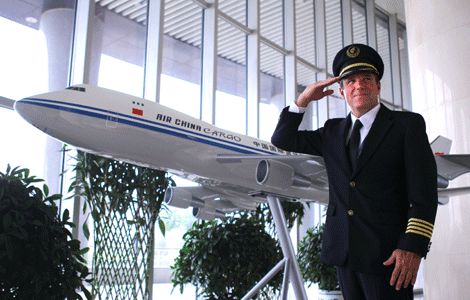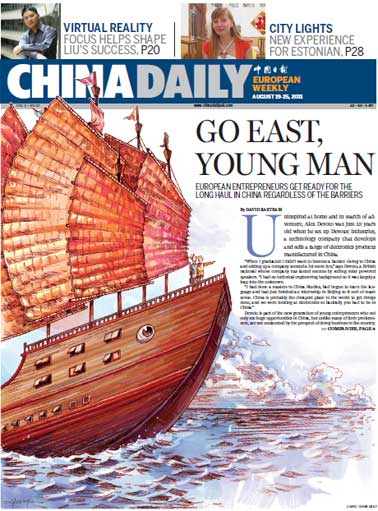China-Europe
The European Union, China and Central Asia – Toward a 21st century new silk road?
Updated: 2011-06-29 15:13
By Augusto Soto (Chinadaily.com.cn)
Speech by Augusto Soto, Professor, ESADE, and global expert in the Alliance of Civilizations of United Nations, at the 9th Euro-China Forum.
Ladies and Gentlement,
Dear Friends,
I want to thank the visionary decision of Mr. David Gosset and Madam Irina Bokova to organize this 9th EU-China Forum. It is a joy and a privilege for me to address a global audience from UNESCO's main hall
Europe and China, as two of the great civilizations in world history are getting closer. Between these two titans lies Central Asia, which historically is a central part of Eurasia thanks to the Silk Road.
A meaningful part of the human process of self-reflection and exchange of dreams, trade, ideas and religious views have taken place along various segments of the Silk Road. We may well say that mankind mirrors itself along this historical superhighway.
On the other side self-perception is a sign of civilization and a valid metaphor or precondition for dialogue. Who am I, who are we? Without introspection, without a mirror a civilized dialogue is impossible. In old Greece Delphos proclaimed: “know yourself”. In ancient China Sun Zi's advice before taking any action was to determine “who we are”.
The thing is that it seems that some of the most vivid introspective processes in mankind's history have taken place in deserts and steppes of Central Asia. Li Bai, who lived in the 8th century and probably the greatest Chinese poet was born near Issyk Kul lake in today's Kyrgyzstan.
His poetry is pervaded by classical motives, inter alia, with the notion of the self, whose metaphorical expression mirrors itself in lakes and is projected in the infinite space. Two centuries later, not far from Issik Kul, within Central Asia's macrospace, fundamental questions emerged. Was the earth created whole and complete or it had evolved over time? Are there other solar systems out among the stars?
As for the first question, at least in a human scale an answer was given two centuries later with the Pax Mongolica. It represented the will to rule the whole and complete space under heaven by administrative measures connecting China, Central Asia and segments of Europe.
As for the second classical question, are there other solar systems out among the stars? Attempts to give an answer came from various Central Asian astronomers. Several centuries later a Eurasian pool of scientists and engineers living along the old and famous Road tried a new answer. It was by sending to the space the Vostok 1, marking the first time a human entered the outer space. The event took place at the space facility of Baikonur, a few kilometers away from Turkistan, UNESCO world heritage site.
Thus, historically speaking we see that overcoming distances is nothing alien to Central Asia.
Nowadays the region has managed to establish ties with both the EU and China. This achievement has been possible thanks to a grandiose political and diplomatic rapprochement worth the annals of universal history. Furthermore, the macro-region is in the process of positioning itself at the vanguard in several hot issues of the global agenda.
One example is integration processes. Ancient continental trade routes have begun to revive. Over the last years international financial institutions have been cooperating building a network of highways that will eventually link Central Asia with China, Europe, India, and the Middle East and even the Persian Gulf (without cultural contact with Muslim Central Asia during most of the XX century). These new routes enrich previous infrastructure linking Central Asia to Russia. Some of these new routes will connect to newer highways via Afghanistan. True, on one hand Eurasia's Western side is facing economic uncertainties. On the other hand Afghanistan's stability seems precarious. But the macro trend of Eurasian integration is clear and seems unstoppable. There is hardly a European macro-infrastructure project looking East whose broad guidelines are not related to the notion of Silk Road. It is present in the idea of TRACECA (Transport Corridor Europe-Caucasus-Asia) and INOGATE (Interstate Oil and GAS Transport to Europe). The conspicuous Asia Europe Meeting (ASEM) has already broached the matter in the Trans Eurasia Information Network, to which is added the Trans-Eurasian Railway project (also called the ‘Iron Silk Road').
Regarding multilateralism Central Asia is also at the vanguard. The five post-Soviet neighbors and China began bilateral approach in the very beginnings of the nineties. Subsequently, the creation of the Shanghai Cooperation Organization set up one of the new roads for Eurasian integration. Actually its members define it as the first regional multilateral organization of the 21st century.
As for EU-Central Asia relations, they date from the break-up of the Soviet Union. Currently dialogue has been reinforced covering exchange almost in all areas. On the other side it is known that EU relations with China were established in 1975 and in less than two generations reached strategic partnership status. As a result, EU-China, EU-Central Asia as well as Central Asia-China relations are now full-fledged and regular exchanges. If there is will, heads of States, ambassadors and diplomats can be at any capital in a matter of hours. From the three sides diplomatic channels are fluid and the exchange is carried out in several languages, echoing past and present Central Asian multiethnic mosaic, European multiculturalism and Chinese diversity.
Certainly a trilateral dialogue is theoretically possible but still not feasible. Can we help to make it possible? Yes, this initiative headed by visionary David Gosset is an important column in this process. Are we ready to talk at the level of civil society? The answer is definitely yes. We can communicate. Central Asia has been changing dramatically even before 1991 and clearly people are also changing in tune with globalizing processes.
We should consider that tens of thousands of the region's students have gone to study to the best universities abroad. These intellectuals not only go to the West but also increasingly to other Eurasian countries such as China. Gradually there is a generation on the way able to speak Tadzhik, Kazakh, Kirguis, Turkmen or Uzbek also able to read or conversant in English and Chinese.
There is also openness in the realm of religions. Former Soviet Central Asia belongs to the Organization of the Islamic Conference. At the same time in the region we also find main universal faiths such as Buddhism, Christianity (Orthodox, Catholic and Protestant), Judaism. Also one can find a variety of secular creeds and ideas that capture the minds of people from more than 130 nationalities. All this is sign of cosmopolitanism.
In addition today we have at our disposal channels that seem to make so many things possible. On the threshold of the XXI century the world achieved a very significant level of connectivity, virtually flattening intercontinental conversation.
Some Central Asia and Eurasia pundits are convinced that history can teach us something. That means that somewhere, as a part of their heritage, there is the capacity of nowadays Kazakhs, Turkmen, Kirguiz, Tadjik and Uzbeks to play again the bridge role between civilizations. I agree with this view.
Other observers think that due to immense geographical distances and in view of recent conflicts in Central Asia it is too early to envisage dialogues including Central Asia, China and EU civil societies.
We should remember that Central Asia is a focal point of some paradigmatic dialogues of our era which constitute bases for further conversations.
For example, let's stress the tremendous historical importance of the Nevada Semipalatinsk Movement, the first anti-nuclear non-governmental organization created in Central Asia. It was born when thousands of people filled the hall of the Writers' Union, in former capital Almaty, to hear Kazak poet Olzhas Suleymenov denounce nuclear testing.
I also ask you to remember the international negotiations leading to the withdrawal of the nuclear warheads from Kazakhstan after the end of the Cold War. It would have been more difficult without a responsible leadership and without a responsible civil society such as the Kazakh.
Certainly let's also remember the hundreds of thousands of daily interethnic dialogues taking place among people at the markets in the Ferghana valley. And let's also hear the talks along the small rivers belonging to Amudarya and Syrdarya water basins aimed at finding better ways to share water.
Let's also call the attention on the ongoing international scientific exchange in biology or physics. Today there is unprecedented scientific exchange between Central Asian scientists and their counterparts abroad. On environmental issues, talks, fora and dialogues have taken place concerning the preservation of the Aral Seal and the Caspian Sea.
It is also worth to have in mind the thousands of daily conversations aimed at the solution of practical matters at Alashankou, a port town in the border of Xinjiang and the Almaty Province of Kazakhstan. This is one of the crucial meeting points of peace and understanding of the new intercontinental Silk Road in the making.
These very few examples, among many, show that Central Asia shares challenges that sound familiar in the EU and in China. It has to do with practical matters as well as with ideas of a Silk Road now really based on a real Oikumene. These, I believe, are significant bases for a new humanism.
Thank you
E-paper

Pearl paradise
Dreams of a 'crazy' man turned out to be a real pearler for city
Literary beacon
Venice of china
Up to the mark
Specials

Power of profit
Western companies can learn from management practices of firms in emerging economies

Foreign-friendly skies
About a year ago, 48-year-old Roy Weinberg gave up his job with US Airways, moved to Shanghai and became a captain for China's Spring Airlines.

Plows, tough guys and real men
在这个时代,怎样才"够男人"? On the character "Man"
